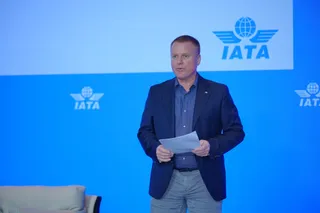Embracing Technology
Contact Our Team
For more information about how Halldale can add value to your marketing and promotional campaigns or to discuss event exhibitor and sponsorship opportunities, contact our team to find out more
The Americas -
holly.foster@halldale.com
Rest of World -
jeremy@halldale.com

Fiona Greenyer explores the use of new technology for cabin crew training, and how it is currently being used in training departments.
E-Learning, mobile learning and the use of social media is becoming more prevalent in today’s training departments. Cabin crew training has traditionally involved the more practical aspects of teaching, but with the development of virtual training programmes, there is far more scope to use e-learning as a significant method of teaching.
Traditional e-learning is usually reserved for situations requiring firm, clear instructions and where there is limited opportunity for user experimentation or practice.
e-learning in its various forms has been used for many years, but not by all. Many training departments are now seeing the benefits of using new technologies, both in cost and time savings. The Inflight Institute.com has been developing learning methodologies and programs for pre-qualification training for potential cabin crews for decades. That developmental knowledge moved to online recurrent training and testing, and at EATS 2013 Ivan Noël, president of Inflight Institute.com spoke about implementing an Integrated Learning Cycle to reach the next level of knowledge. “We have wonderful opportunities to develop, create and support our crew through the use of technology.” His company’s focus is now on post-training. The company objective is to create the most knowledgeable crew, using training technologies to reduce the cost of errors and training.
The Integrated Learning Cycle at Inflight Institute.com provides an enhanced user experience and incorporates multiple learning styles which provide a blended learning approach. Instant feedback allows the instructor to alter the lesson dynamics as required and it can identify individual gaps in knowledge which can then be dealt with and reinforced to ensure complete understanding of a subject. Noël observed that a blended learning approach has been found to provide a superior platform to reach knowledge goals.
Interactive Learning
Canadian company Teknoledge was founded in 2011 and provides out-of-the-box multimedia, virtual reality and interactive immersive 3D products usable either as e-learning, m-learning or standalone instructional material. The company has developed an Airbus A320 cabin trainer which is a fully interactive 3D simulation tool and allows the user to move into the cabin and control seats, tablets, doors, overhead bins, slides, emergency exits, cabin attendant panels, oxygen masks, inter-phone and more.
Fred Charleux, president of Teknoledge, commented: “We believe that immersive virtual reality and soft simulation will count for a huge percentage of the oncoming instructional products. This prediction is not only based on the growing potential of information technologies, but also takes into consideration that Internet-based immersive training is more cost effective, standardized, and ensures safer and cleaner reusable products than classic training.”
Swedish company Virtual eTraining has developed an interactive, and affordable, 360° virtual training environment concept that can be used to interact in high resolution visual environments, specific to the customer. The 360° images can be used for students to explore, interact or train in scenarios in a life-like environment and can be applied to many different training areas. Depending on the product model used, the company can provide everything from simple walk-around solutions for pre-flight inspections and equipment location training to full course models with LMS integration, suitable for initial, conversion, service or recurrent training.
The company’s ‘Tour Model’ is a scaled-down walk around solution that allows students to navigate in a virtual 360° environment, (inside or around an aircraft) and includes multimedia hotspots containing stills, instructional videos and texts. This can be used for pre-flight inspections, familiarization with aircraft systems or location of emergency equipment in preparation for a line check. ‘Course Model’ has the same functionality as the ‘Tour’ with the addition of an examination functionality and feedback via an optional Learning Management System (LMS).
The learning methodology adopted by Virtual eTraining lets the user freely explore the virtual environment in a learning mode or allows them to be led through different scenarios prompted by the software. Unlike traditional e-learning, this training requires a high level of user activity which provides meaningful transfer and retention of knowledge. The user is left to learn, review and explore scenarios or environments at their own pace, while providing an appropriate level of challenge and intrinsic feedback on the users’ performance via the software’s test mode.
Norwegian Air Shuttle has partnered with Virtual eTraining and co-produced a walk-around course that aims to improve, modernize and create future cost savings in cabin crew training through the development of an online pre-course, as well as recurrent training based on a virtual 360° cabin interior. The course includes modules on the location and use of emergency equipment and the operative management of first aid and emergency procedures.
The airline’s cabin crew undergo this e-learning course which includes a mandatory annual recurrent exam which they take before arriving at the training centre. This enables the airline to free up time for practical hands-on training and qualitative discussions, removes the stress related to the mandatory exam and reduces and automates administration.
By implementing this course Norwegian Air Shuttle will be able to reduce their annual cabin crew recurrent training from two days in the classroom to only one day, which will save significant amounts annually for the airline. Members of the Norwegian Air Shuttle training team and Virtual eTraining will be presenting more on this case study at WATS 2014.
Air Berlin is also using the cabin interior walk-around product from Virtual eTraining. They use this as an interactive and web based tool for cabin crew to use in their initial and recurrent training program. The tool allows the cabin crew to navigate inside the aircraft and locate emergency equipment and get the necessary information about its functionality and use by visiting multimedia hotspots containing stills, instructional videos and text.
Application
Both Delta Air Lines and GoJet Airlines have adopted new forms of learning recently. Following their merger with Northwest, Delta In-Flight Service are using new technology to improve the training experience for flight attendants, training department staff, instructors, and ultimately the customer. The airline was aware that it needed to better prepare their flight attendants for addressing problems associated with the In-Flight Entertainment system. An interactive ‘app’ was developed that could be installed on a tablet and the IFE system replicated in a hands-on learning environment. This resulted in the IFE Trainer. The end result of this training system was that flight attendants could more easily troubleshoot the system without causing a maintenance write-up. It gave Pursers and Flight Leaders more confidence in the system, when previously their biggest issue was fear, and it improved customer service on board.
In November of 2012, GoJet Airlines converted from hard copy Operations and Training manuals to issuing a Samsung Galaxy tablet to every employee and student, consequently changing the entire manual process. This move required a revision of the established processes internally, and most importantly, FAA approval. Establishing an email link with every employee was paramount to maintain communication, and ensuring compliance. Once these steps were accomplished, the launch, education, “training an old dog new tricks”, and ensuring a solid, comfortable working knowledge on-line, and in the classroom, followed. Challenges the airline has faced include instructor transition, personal use of the tablets, not just being used for training purposes! Updates to software can have an impact on tablet screens, therefore altering how the tablet is navigated.
Tammy Hoevel and Michaela Green from GoJet Airlines will be at WATS 2014 and will be looking at how generation gaps, teaching style differences amongst instructors, and personnel changes can have an impact on the delivery of training and its outcome. How training departments can ensure consistency of the materials being provided whilst capitalizing on the strengths and value every generation brings to the process will also be explored.
Use of Technology
The cabin crew conference at WATS 2014 will contain a number of presentations that are focusing on the use of technology, either at the training stage or on board the actual aircraft. Larry Parrigin, Manager of Curriculum and Program Development at Southwest Airlines will be focusing on ‘Providing Crewmembers with Skills to Deal with Social Media’. Passengers can and will document every facet of their airline experience from take-off to landing through various social media platforms. Questions being asked, and answered, will include how do the all-seeing social media networks impact the flight attendant’s ability to do their job? And are airlines adequately equipping crew members with the skills needed when dealing with social media on board the aircraft? The issue of managing social media use when passengers’ lives are at risk and how that use impacts a flight attendant’s decision-making process will also be examined and explored.
Candace Kolander, Coordinator Air Safety, Health & Security, Association of Flight Attendants, Washington, DC office will present on the ‘Inflight use of passenger PEDs and cabin safety, flight attendant perspective’. The FAA recently published guidance to aircraft operators that allows expanded use of passenger portable electronic devices (PEDs) throughout the flight. Under these new policies, airlines are allowing passengers to use small, handheld devices during taxi, take-off and landing. This presentation will explore several concerns, from the flight attendant perspective, related to the potential impacts of these new policies on safety in the aircraft cabin. With passengers now able to use PEDs during all phases of flight, including during crewmember briefings, flight attendants are concerned that important safety information will be ignored.
Safety issues also surround the use of PEDs onboard in the possibility that sudden crash forces could cause passengers to lose hold of their PEDs, resulting in ‘struck-by’ injuries to occupants. Kolander will also look at passenger behavior one might encounter during actual aircraft evacuations. Policies allowing PEDs to be ‘secured’ in-hand may lead to various unintended consequences such as passengers needing to stop and search for their device in the aftermath of a crash, even at the cost of slowing down the cabin evacuation.
There are many ways that technology is now being integrated into the training process, some of these will be highlighted at WATS 2014, while others continue to be developed, and no doubt will be the focus of future conference sessions.


.png/r%5Bwidth%5D=320/7f2021f0-9a0d-11f0-b8f7-272ce5993c28-nano-banana-2025-09-24T11-07-03%20(1).webp)